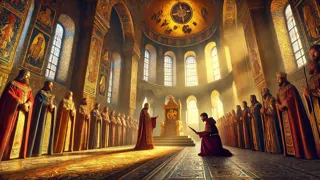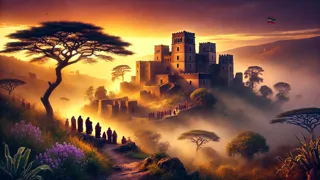Introduction
The legend of Prester John, shrouded in the golden mist of medieval imagination, traveled across continents on the parchment wings of merchant letters, crusader chronicles, and the hushed prayers of wandering monks. In the great stone halls of Europe, the name itself conjured visions of a kingdom awash in miracles: rivers of gems, lands where the lion and the lamb lay together, and a king both priest and monarch, ruling with a wisdom that seemed carved from the bedrock of Eden. Ethiopia, land of rugged mountains and deep, hidden valleys, became the heart of these dreams—a place where old faiths clung like moss to ancient obelisks, and new Christian hope shone from candlelit churches dug into the earth. This was an age when borders blurred between the real and the miraculous. The world knew little of Africa’s vast interior, and what little reached Europe’s ears was transformed by longing and the feverish hope for allies against encroaching darkness. In this world, Prester John became more than a king: he was a beacon, a living promise that somewhere, far from the troubled realms of Christendom, a pure and mighty Christian kingdom endured. His legend took on a life of its own, inspiring adventurers, priests, and even emperors to send emissaries and letters into the unknown. Yet behind the stories and the prayers, behind the maps inked with guesswork and hope, there lies the question: was Prester John ever real, or was he born from the yearning of a world desperate for wisdom and salvation? This is the story not just of a man or a kingdom, but of the power of belief—the way a legend can bridge oceans, lift weary souls, and bind distant peoples in a shared longing for light. In the heat of an Ethiopian dawn, where acacia trees stretch their arms to a sun older than memory, let us walk the red earth and listen for footsteps lost to history. Let us seek Prester John—not merely the man, but the promise that somewhere, wisdom and faith endure, waiting to be found anew.
The Letter That Changed the World
In the year of our Lord 1165, as legend has it, a letter arrived at the court of Emperor Manuel Komnenos in Constantinople. Its vellum was creased from a journey across deserts, over seas, and through the cautious hands of merchants and monks. It bore a curious seal—a lion intertwined with a cross—and within its elegant script lay promises that would ignite a century of wonder. The letter spoke of Prester John, a Christian king ruling a realm beyond the known world, a land where faith had blossomed untouched by the wars and heresies that ravaged Europe. According to its words, Prester John’s kingdom overflowed with marvels: fountains that healed the sick, fields that yielded jewels instead of stones, and a court where wise men from every nation gathered in peace. Most enticing of all, the letter promised friendship and aid to Christian kingdoms beset by Saracen armies. Rumors spread like wildfire. In cloistered monasteries from Paris to Toledo, monks pored over the words by candlelight, tracing each sentence with trembling fingers. In the bustling markets of Venice, merchants whispered of a kingdom richer than any imagined in the West. Even kings and popes dispatched envoys and letters, desperate to find this distant ally. The world’s eyes turned south and east—toward the fabled lands of India, and then, as stories twisted and grew, toward Ethiopia.

Ethiopia was itself a land of legend. Its highlands hid ancient churches hewn into living rock, their doors shadowed by incense and echoing chants. The Solomonic dynasty claimed descent from the union of King Solomon and the Queen of Sheba; the Ark of the Covenant, some whispered, rested within the chapel at Axum. Its people had endured centuries of isolation, war, and faith—threading Christian rituals with the music of older gods and older hopes. For European minds restless with crusades and loss, Ethiopia seemed the perfect cradle for Prester John’s kingdom: distant enough to be mysterious, yet linked by a thin golden thread of faith.
Yet for all the longing and the letters, no embassy ever found Prester John’s court. Travelers like Benjamin of Tudela and Marco Polo returned with tales of wonders, but no proof. As years passed, the legend only grew. Each retelling added new marvels: a mirror that revealed the hearts of men, rivers that ran sweet as honey, towers that touched the clouds. It was as if the world needed Prester John to be real—needed him to stand as a bulwark against despair.
But what if the legend hid a deeper truth? In the villages of Ethiopia, old men gathered children by the fire to tell stories not of a distant king, but of Wazema—the wise patriarch who walked among the people in simple robes, whose counsel soothed feuds and whose prayers brought rain. Some said he was Prester John in disguise; others claimed he was a spirit sent to remind people that wisdom lies not in gold or power, but in kindness and faith. The monks at Lalibela, carving new Jerusalem from solid stone, chanted for guidance not from a faraway king, but from God dwelling in every heart. And still, the world searched on, mapping rivers and mountains by rumor and dream.
Journey Through Ethiopia’s Sacred Highlands
Centuries after the letter’s arrival, another seeker set foot upon Ethiopian soil: Brother Matthieu, a French Benedictine driven by tales of Prester John since his novitiate days. Tall, thin, eyes bright with questions, he carried only a leather-bound psalter and a pouch of gold coins—a meager inheritance from a family gone to plague and poverty. In the port city of Massawa, he watched camels lumber under towering baobabs, their drivers’ voices ringing in Arabic and Ge’ez. The air thrummed with heat and the scent of cloves, dust, and salt. Matthieu’s first days were spent searching for a guide who could take him inland, to the heart of the highlands where legend said Prester John dwelled. Many laughed at his quest. Some demanded more gold. One old merchant—Ayanu, skin weathered as river stone—took pity on him. “You seek a king? Seek first the mountains. If there is wisdom in Ethiopia, it lives among the clouds.”

With Ayanu as his companion, Matthieu began the ascent. They traveled through fields of teff and golden wheat, past villages painted in ochre and blue, their thatched roofs shining in the morning light. Children ran alongside their donkeys, waving sprigs of wildflowers. At night, beneath a sky glittering with unfamiliar stars, Ayanu told stories: of Lalibela, the new Jerusalem; of Lake Tana, where ancient monasteries floated on emerald waters; of lions and leopards that guarded sacred groves. The land itself seemed enchanted—churches chiseled from living rock, guarded by white-robed priests who welcomed strangers with bread and honeyed beer.
In the city of Gondar, its castles rising like dreams from green hills, Matthieu glimpsed the shadow of Prester John. He met Emperor Dawit, who ruled with dignity and sorrow. “You seek Prester John,” Dawit told him, “but you have found Ethiopia. Our kingdom is not made of gold, but of endurance and hope. Here, we keep faith alive through famine and war.” Dawit led Matthieu to the Debre Berhan Selassie church, its ceiling alive with angels—hundreds of painted eyes watching, each a guardian against darkness. Matthieu knelt in prayer and felt a presence: not a king on a throne, but a spirit that lingered in every voice raised in hymn, every hand extended in welcome.
Their journey pressed deeper, to Axum’s ancient obelisks and the cave monasteries where monks spent lifetimes in contemplation. In one such monastery, hidden among the crags of Tigray, an old abbot told Matthieu: “Prester John is not a man. He is a hope carried in every heart that longs for justice and peace.” The words echoed in the cool, incense-filled air. Matthieu wrote letters home, his words filled with awe and humility: “Here, faith is not thunder and miracles, but patient as rain. I have found no king of legend, but a people who endure and love and believe. Perhaps that is the greater miracle.”
One dawn, at the edge of the Simien Mountains where cliffs fell away to valleys green as jade, Matthieu stood in silence. The wind carried the sound of distant chanting, bells ringing out over the mist. He closed his eyes and imagined the world as it could be—united by hope, by kindness stronger than iron. In that moment, he understood: sometimes the greatest legends are those that lead us home to ourselves.
Conclusion
So the legend of Prester John endures—not as a fixed truth carved in stone, but as a living dream woven into the tapestry of human longing. In every corner of medieval Europe and far beyond, his story became a bridge between worlds: a spark of hope for those beset by fear, a compass for explorers hungry for wonder, and a parable whispered by elders to remind us that wisdom may dwell in unexpected places. Ethiopia’s mountains still shelter ancient churches and chanting monks; its valleys still cradle faiths as old as time. The quest for Prester John, whether pursued across deserts or within one’s own heart, teaches that true wisdom is found not in distant kingdoms or miraculous riches, but in the courage to believe, to endure, and to keep searching for light in the darkness. Legends grow because we need them—because somewhere between what is real and what is hoped for, we become more than we were. In the end, Prester John is not lost; he lives in every heart that dreams of a better world.


















